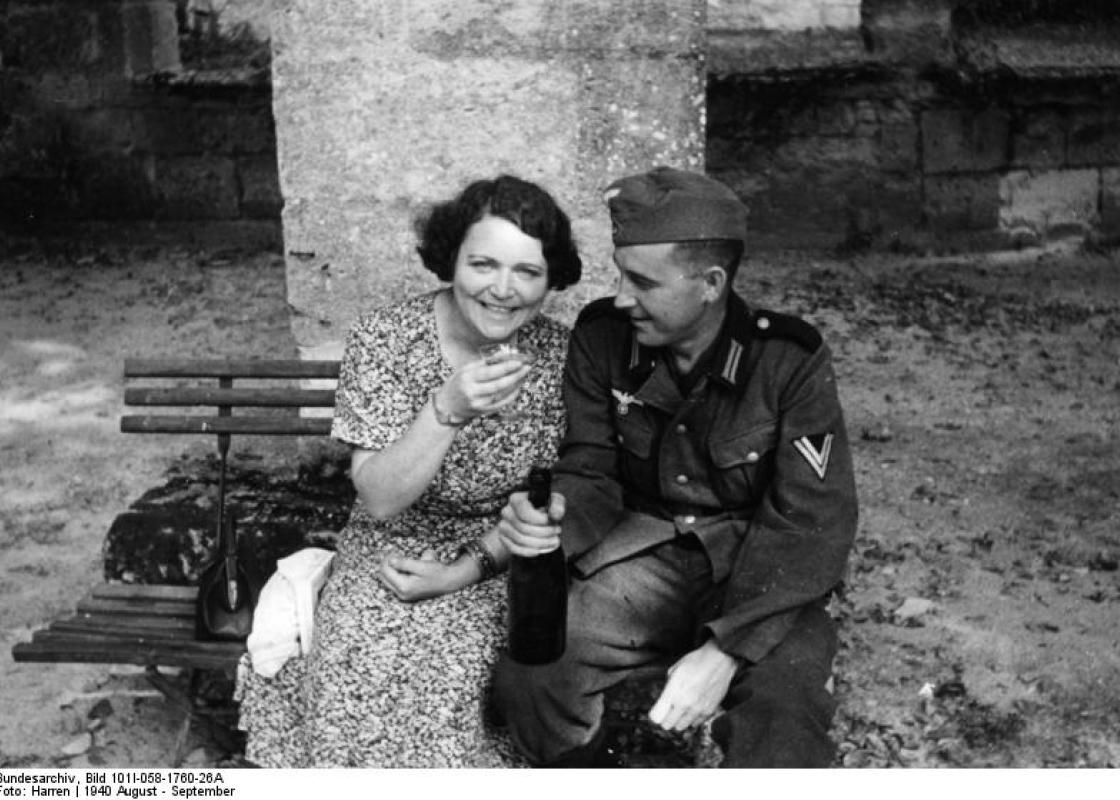While most Norwegians celebrated the Liberation in the spring of 1945, at least five thousand Norwegian women were interned in approximately twenty internment camps around Norway for up to 120 days. The largest camp was located just outside Oslo, on the Hovedøya island.
They were called “German girls” or “German whores” (Norwegian: tyskerjente, tyskertøs), since they had been involved with German soldiers or worked for the Germans during the war, as for instance cleaners or seamstresses. These were not criminal acts such as holding a membership in the Norwegian fascist party Nasjonal samling (“National gathering”) or spying for the Germans were. Therefore, the handling of these women did not form part of the official legal purge.
A type of prison
These women were nevertheless punished, according to Professor Knut Papendorf, Jurist and Professor at the Department of Criminology and Sociology of Law at the University of Oslo. They weren’t only punished by the general public who cut their hair off, took away their jobs, and excluded them from Norwegian society. They were also punished by Norwegian authorities.
“The police, fronted by the Head of the National Police and the Department of Justice, did also take part in an unlawful quasi-penal sanctioning of a defenceless group in society. The internment was a type of prison,” claims Papendorf.
A way to subdue the hatred
In his latest book “Charged as German Whore. The Trials in a Broader Context” (Siktet som tyskertøs. Rettsoppgjøret i videre forstand), he claims that the Norwegian governmental bureaucracy punished those who couldn’t be sentenced. Officially and legally, the internment was not regarded as a sentence, but rather as protection against people’s hatred and as a measure to avert the transmission of sexual diseases.
“People were outraged because these women had been too close with the Germans. There was a strong public hatred towards them, and the authorities felt that something had to be done,” says Papendorf.
The primary sources for his book are the case documents of the 347 women who were interned, and later released, at the Hovedøya camp just off the Oslo coast in 1945. The police interrogations of these women only form a small part of the National Archive’s extensive documentation of the handling of these women after the war. The rest is still exempt from public disclosure.
Assembly line internment
Two provisional arrangements, that is temporary regulations ordered by the exile government in London, made internment possible without having to go through the National Court. The process was handled by the police or the health authorities and required no ruling.
“This made the process far less time-consuming. The police could just say, ʻyou, by such and such name, are to be interned because of this or that for thirty days, ’” says Papendorf.

If the police found the case to be of a more serious character it was sent to the Chief of the National Police who had the authority to extend the sentence to 120 days.
“The handling of these cases happened in accordance with the assembly line principle. In one instance, the police asks for approval from the Chief of the National Police to intern 38 women all at once. This is contrary to every principle within criminal law,” says the legal scholar.
Protection against public justice
The official reasons were first and foremost to protect women “who are or are in danger of being exposed to injury from the public due to the presumption of unnational sympathies.”
Secondly, the authorities were worried about the transmission of sexual diseases among prostitutes who had been in contact with the many German soldiers during the occupation.
With authorisation in the so-called infection regulation, the health authorities could intern women who were presumed infected with a sexual disease “at a hospital or elsewhere… when … there are reasonable grounds for presuming that the woman in question may infect others.”
“Similar to a concentration camp”
Adolf Hals, the second in command at Hovedøya, gave the following description of the camp in an interview more than forty years later:
“No, we never regarded it as a prison. The internment was a medically preventive measure where women who were presumed infected could be held up to three months… […] But of course, - when looking back at it today people may react to the camp bearing similarities to a concentration camp.”
In theory, the infection regulation applied to both sexes, but no men were interned in order to avert the transmission of sexual diseases.
The twenty-eight men who married German Wehrmacht women received no penalties while women who married Wehrmacht men were deported and deprived of their citizenship, according to the newspaper Bergens Tidende.
Sleeping with the enemy was only a woman’s problem.
A double betrayal
The hatred towards the German whores was manifested in e.g. the so-called haircutting campaigns, where women who were considered to have fraternised with the enemy were dragged out in the streets where their hair was cut off as punishment.
According to the Danish researcher Anette Warring, women’s sexuality becomes national and masculine property during wartime, and sexuality is given particular symbolic value. To literally sleep with the enemy is thus regarded as a double betrayal.
Haircutting as manifestation of patriotism
On the 13 May 1945, a nineteen year-old woman was drawn out of her home by approximately forty young men from Kjelsås in Oslo who cut her hair off, according to the police’ interrogation report. She had been in a relationship with a German subordinate officer and worked as a scullery-maid for the Germans during the war.
According to Papendorf, the haircutting campaigns were also a way for some people to conceal their own guilty conscience for not having actively participated in the resistance during the war.
“The haircutting may be understood as a manifestation of one’s own patriotism. By participating in the haircutting campaigns people proved to themselves and others that they were true patriots,” he says.
According to Papendorf, it was not unusual for the Resistance movement to participate in these campaigns, either actively or passively.
“Neither the Resistance movement nor the police did anything to stop the haircutting campaigns, even though their task was to prevent lawlessness in the chaotic aftermath of the Liberation.”
Representative for Norwegian women
“In their own age, the so-called German Whores were described as ignorant and naïve women from the lowest classes of society,” says the researcher.
For instance, the Norwegian Newsreel had a news story from the largest internment camp at Hovedøya outside of Oslo, where they stipulated that 75 per cent of the women were infected by sexual transmitted diseases.
However, the 347 case files from Hovedøya give a completely different picture, according to Papendorf. They show that only 20 per cent were infected.
“It was complete and utter nonsense. The women at Hovedøya weren’t prostitutes or so-called promiscuous. On the contrary, they were fairly representative for Norwegian women of their time,” he claims.
Unnational attitudes
According to Papendorf, it becomes clear from the police’ interrogation reports that the women’s so-called unnational attitudes was the primary reason for the internment, since most of them were neither in need of protection nor infected by sexual transmitted diseases.
Examples of unnational attitudes were “German labour”, “formal marriage engagement”, “wearing a German uniform”, and “highly impertinent“.
The women are referred to as “accused” and “suspects” in the interrogation documents although legally they were not accused of anything criminal. Some of the cases are “dismissed” when the police were unable to find any reasonable grounds for internment.
“The rhetoric used by the police in these cases strengthens my impression that the women were punished, regardless of whether these women experienced actual threats,” claims Papendorf.
Sexualised by the police
In addition to questions related to German labour, the police was concerned with the women’s sex lives, according to Papendorf.
It appears from the interrogation reports that the women were frequently asked how many times they had intercourse with German soldiers and how many German soldier friends and boyfriends they had.
But the reports also show that many of the women refused to answer the most intimate questions from the police.
“Refuses to say how many people she has had sexual intercourse with”, says one police report dated November 1, 1945.
Another woman replied: “I don’t want to answer whether or not we’ve been in a relationship; it’s a private matter.”
In love with the enemy
Several women said that they felt no need for protection against the public hatred and that they were fully able to cope.
“It becomes clear from the interrogation reports that the women rejected the police’ description of the case and refused to regard their relationships to German soldiers as something criminal. The reports give a picture of these women which is far from the contemporary portrayal of them as ignorant and naïve,” says Papendorf.
To many of the women who were interned at Hovedøya their only “crime” was to have fallen in love with the enemy.
Translated by Cathinka Dahl Hambro.
- Approximately 100.000 Norwegian women were involved with one or more men who served under the Germans during the Second World War.
- These women were subject to harsh reactions both from the general public and from the authorities during the first months after the Liberation in May 1945.
- Thousands of women were victims of the so-called haircutting campaigns where they were attacked by a mob who cut off their hair.
- At least five thousand women were interned by the authorities in 1945, at internment camps all over the country.
- The largest camp was located at Hovedøya, an island just off the Oslo coast.
- Knut Papendorf is a Jurist and Professor at the Department of Criminology and Sociology of Law at the University of Oslo.
- His book Siktet som tyskertøs. Rettsoppgjøret i en videre forstand (“Charged as German Whore. The Trials in a Broader Context”) appeared recently. It examines the handling of the so-called German whores by the police and the health authorities.



